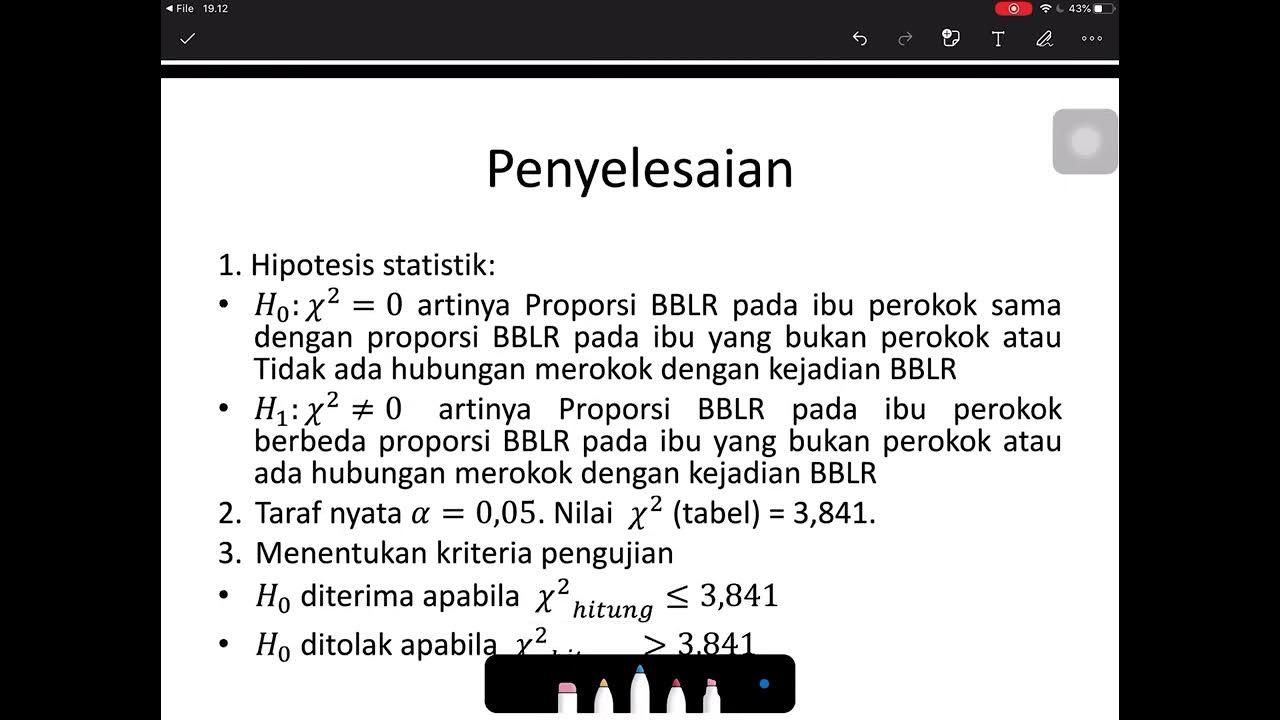SYARAT MENGGUNAKAN UJI CHI SQUARE DAN FISHER EXACT
Summary
TLDRThis video explains the differences between the Chi-Square test and Fisher's Exact test, both used to examine the relationship between two categorical variables. The Chi-Square test is suitable when specific conditions are met, such as the absence of zero values in the contingency table and certain expected frequencies. If these conditions aren't met, Fisher's Exact test is used instead. The video also covers the calculation of expected values in contingency tables and provides examples to illustrate how and when each test should be applied in research, particularly in studies of associations like smoking status and coronary heart disease.
Takeaways
- 😀 Chi-Square Test and Fisher's Exact Test are both used to examine relationships between two categorical variables.
- 😀 These tests are applied when the variables are either nominal or ordinal in nature.
- 😀 The relationship analyzed between variables is typically cause-and-effect or association.
- 😀 The independent variable (predictor) and dependent variable (outcome) are both categorical in these tests.
- 😀 The Chi-Square Test requires that there are no zero values in the contingency table.
- 😀 In a 2x2 table, no cell should have an expected frequency less than 5 for the Chi-Square Test to be valid.
- 😀 For tables larger than 2x2, no more than 20% of cells should have expected frequencies below 5 for the Chi-Square Test.
- 😀 Fisher's Exact Test is used when the conditions for the Chi-Square Test are not met.
- 😀 Fisher's Exact Test is particularly useful when small sample sizes or low expected frequencies exist.
- 😀 The expected frequency for each cell in a contingency table is calculated using the formula: (Row Total * Column Total) / Grand Total.
- 😀 If any of the Chi-Square Test conditions are violated, Fisher's Exact Test should be used as an alternative.
Q & A
What is the purpose of the Chi-square test?
-The Chi-square test is used to assess the relationship between two categorical variables (nominal or ordinal) and determine if there is an association between them.
What are the key conditions for using the Chi-square test?
-The key conditions for using the Chi-square test are: 1) No cell in the contingency table should have a value of 0, 2) In a 2x2 table, no expected value should be less than 5, 3) For larger tables, the percentage of cells with expected values below 5 should not exceed 20%.
When should you use Fisher's Exact Test instead of the Chi-square test?
-Fisher's Exact Test should be used when the conditions for the Chi-square test are not met, particularly if any expected value in the contingency table is too low.
What does Fisher's Exact Test do?
-Fisher's Exact Test is used to determine if there are nonrandom associations between two categorical variables, particularly when the sample size is small and the expected frequencies are too low for the Chi-square test to be valid.
What are the differences between the Chi-square test and Fisher's Exact Test?
-The main difference between the two tests is that the Chi-square test is used when the expected values are sufficiently large, while Fisher's Exact Test is used when the expected values are small or violate the conditions of the Chi-square test.
How do you calculate expected values in a contingency table?
-Expected values are calculated by multiplying the row total by the column total for each cell and then dividing by the grand total of all the values in the table.
What does it mean when a cell in a contingency table has an expected value less than 5?
-If a cell in a 2x2 table has an expected value less than 5, the Chi-square test cannot be used, and Fisher's Exact Test should be applied instead.
In a contingency table with dimensions larger than 2x2, what is the rule regarding expected values less than 5?
-In tables larger than 2x2, up to 20% of the cells can have expected values less than 5, but not more than that.
What is the relationship between the two variables in the Chi-square and Fisher's Exact Test?
-Both tests are used to examine the relationship or association between two categorical variables, where one variable is considered independent (explanatory) and the other dependent (outcome).
Can the Chi-square test be used for variables with non-categorical data?
-No, the Chi-square test is specifically designed for categorical data, either nominal or ordinal. It cannot be applied to continuous variables.
Outlines

Этот раздел доступен только подписчикам платных тарифов. Пожалуйста, перейдите на платный тариф для доступа.
Перейти на платный тарифMindmap

Этот раздел доступен только подписчикам платных тарифов. Пожалуйста, перейдите на платный тариф для доступа.
Перейти на платный тарифKeywords

Этот раздел доступен только подписчикам платных тарифов. Пожалуйста, перейдите на платный тариф для доступа.
Перейти на платный тарифHighlights

Этот раздел доступен только подписчикам платных тарифов. Пожалуйста, перейдите на платный тариф для доступа.
Перейти на платный тарифTranscripts

Этот раздел доступен только подписчикам платных тарифов. Пожалуйста, перейдите на платный тариф для доступа.
Перейти на платный тарифПосмотреть больше похожих видео
5.0 / 5 (0 votes)






